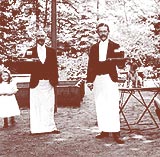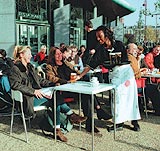Beer Tasting
 Taste
is one of those senses we tend to take for granted. If pushed we could summon
up some descriptive powers but most of the time we prefer the standards 'Good,
Bad or Average' to cover an enormous range. Not everyone feels comfortable copying
the tasting experts who sometimes appear to deluge praise on everyday food and
drink so that even a cup of coffee can have a beautiful, summery woodsmoke and
gunpowder twang.
Taste
is one of those senses we tend to take for granted. If pushed we could summon
up some descriptive powers but most of the time we prefer the standards 'Good,
Bad or Average' to cover an enormous range. Not everyone feels comfortable copying
the tasting experts who sometimes appear to deluge praise on everyday food and
drink so that even a cup of coffee can have a beautiful, summery woodsmoke and
gunpowder twang.
Ask most people why they drink a particular beer and the
answer will be invariably because 'It's good and I like it'. Do we really need
to know that a particular brew has a 'flowery base note'or that its 'mouthfeel
is pungent potassium'. Of course not. But consistent quality beer would be harder
to come by if experts didn't use a dictionary of description where most would
make do with a one-word answer. The aroma and taste of a beer are, naturally,
crucial to its success and, to build loyalty to a particular brew, the customer
has to be guaranteed that it will have the same quality every time. Variations
cause dissatisfaction and a lost customer.
Tastebuds reign supreme
 Most
breweries invest heavily in quality control to maintain brewing process standards
but Heineken has a unique ‘sensory lab’ that became the first of
its sort to get official accreditation for its work in descriptive quality control.
With the company selling around 98 million hectolitres of beer each year in
more than 170 countries, keeping a close eye on taste is a combination of artistic
flair and technical discipline.
Most
breweries invest heavily in quality control to maintain brewing process standards
but Heineken has a unique ‘sensory lab’ that became the first of
its sort to get official accreditation for its work in descriptive quality control.
With the company selling around 98 million hectolitres of beer each year in
more than 170 countries, keeping a close eye on taste is a combination of artistic
flair and technical discipline.
Testers can pinpoint the most
minute taste sensation and then describe them. The words Leathery, Papery, Caramel,
Grassy and Floral may not seem important words in brewing but they are key indicators
as to as overall taste. The ability to track them and others ensures that a
beer tastes good every time. For instance, Heineken insists that its beer is
constant whether you buy it in Africa, Alaska or America.
All the senses come into play
but the tongue, with 10,000 tastebuds, is the leader. The beer stimulates receptors
on the tongue which pick up shades of sweet and bitter and nerves transmit the
results to the brain. Sounds technical? It is exactly the process we all use
when we take a drink of beer. The subconscious does all that complex work, leaving
the drinker with a simple ‘good’ or 'bad' judgement.
Relaxing tastes
 Heineken
is a fruity beer. It is typical of North European beers with a smooth, mild
bitterness and no defects. The customer does not need to know that detail but
it has to be the best beer possible – in line with what he or she had
yesterday, last week or last month.
Heineken
is a fruity beer. It is typical of North European beers with a smooth, mild
bitterness and no defects. The customer does not need to know that detail but
it has to be the best beer possible – in line with what he or she had
yesterday, last week or last month.
Samples arrive daily at Ronald Nixdorf’s laboratory,
which resembles a relaxed café-bar rather than a chemical testing zone.
A team of around 50 trained tasters are given glasses of beer to analyse with
nothing more technical than their senses of aroma and finely-tuned tastebuds.
They are not told the brewery or country of origin. The room is furnished with
light wood and stainless steel with dimmed lights and an extra-clean atmosphere
to avoid any flavour coming into the process. Tasters must not see the shape
of bottles the samples are poured from because we do not want any influence
involved.
Some tastes may not even reach the human detection
thresh-hold but the team still explore every section of the beer’s taste
to ensure Heineken is the best every time.
“We had one taster who could even tell the
difference between the same beer brewed in separate breweries just a few miles
from each other – he was a unique talent and it gives you an indication
as to the levels of detection this can be taken,” says Ronald Nixdorf,
senior scientist, corporate sensory evaluation at Heineken.
'The object is to pinpoint exactly any difference
from the normal. You have to concentrate very hard to isolate a particular aroma
and then you need to be able to describe it. That is where the words we use
come into play.'
Hey, good looking
 Heineken
is the world's most international beer with 22 million hectolitres sold worldwide
and its quality is subject to constant assessment.
Heineken
is the world's most international beer with 22 million hectolitres sold worldwide
and its quality is subject to constant assessment.
Ronald Nixdorf, previously of the University of Utrecht,
is an expert in the psychology of chemical measurement, which means he has to
translate all those flowery descriptions into relevant information. Although
the senses are cleanest at 8 a.m., his team tastes samples from 11 a.m. to 2
p.m. because few drink so early in the morning and any results would be 'unnatural'.
The tasting team have graduated from a sophisticated training scheme and develop
a clear image of what a beer is to taste like.
You can try to put their expertise into practice with a simple five stage tasting
routine: Look at the colour and presentation of the beer; Smell the aroma (look
for a lightly fruity note with Heineken); Taste the beer and let the tongue’s
tastebuds go to work;
Touch is defined by the ‘Mouth-feel’ when you have taken a drink
and finally Reflect on the overall impression of the beer on all the senses.
Satisfied? Then carry on drinking.
“It is very important for the company which
values taste above all. Heineken is a premium brand which people recognise from
a distance. They know what they are getting and that has to be true of every
beer.” Brewers will still invest millions in technology but there is no
machine yet that can handle the complexity of taste and aroma better than the
human senses. Food and drink preparation remain the realms of the personal touch
no matter how advanced technology becomes.
“If you like, we do all the hard-edged tasting
that requires intense concentration so that the customer can simply get on with
enjoying the beer,” says Ronald Nixdorf. So,
even if you can’t quite summon up poetic justice to describe that drink
in front of you, rest assured that someone has done it all for you and your
only tasks are to sit back, relax and have a drink.
 Taste
is one of those senses we tend to take for granted. If pushed we could summon
up some descriptive powers but most of the time we prefer the standards 'Good,
Bad or Average' to cover an enormous range. Not everyone feels comfortable copying
the tasting experts who sometimes appear to deluge praise on everyday food and
drink so that even a cup of coffee can have a beautiful, summery woodsmoke and
gunpowder twang.
Taste
is one of those senses we tend to take for granted. If pushed we could summon
up some descriptive powers but most of the time we prefer the standards 'Good,
Bad or Average' to cover an enormous range. Not everyone feels comfortable copying
the tasting experts who sometimes appear to deluge praise on everyday food and
drink so that even a cup of coffee can have a beautiful, summery woodsmoke and
gunpowder twang.

